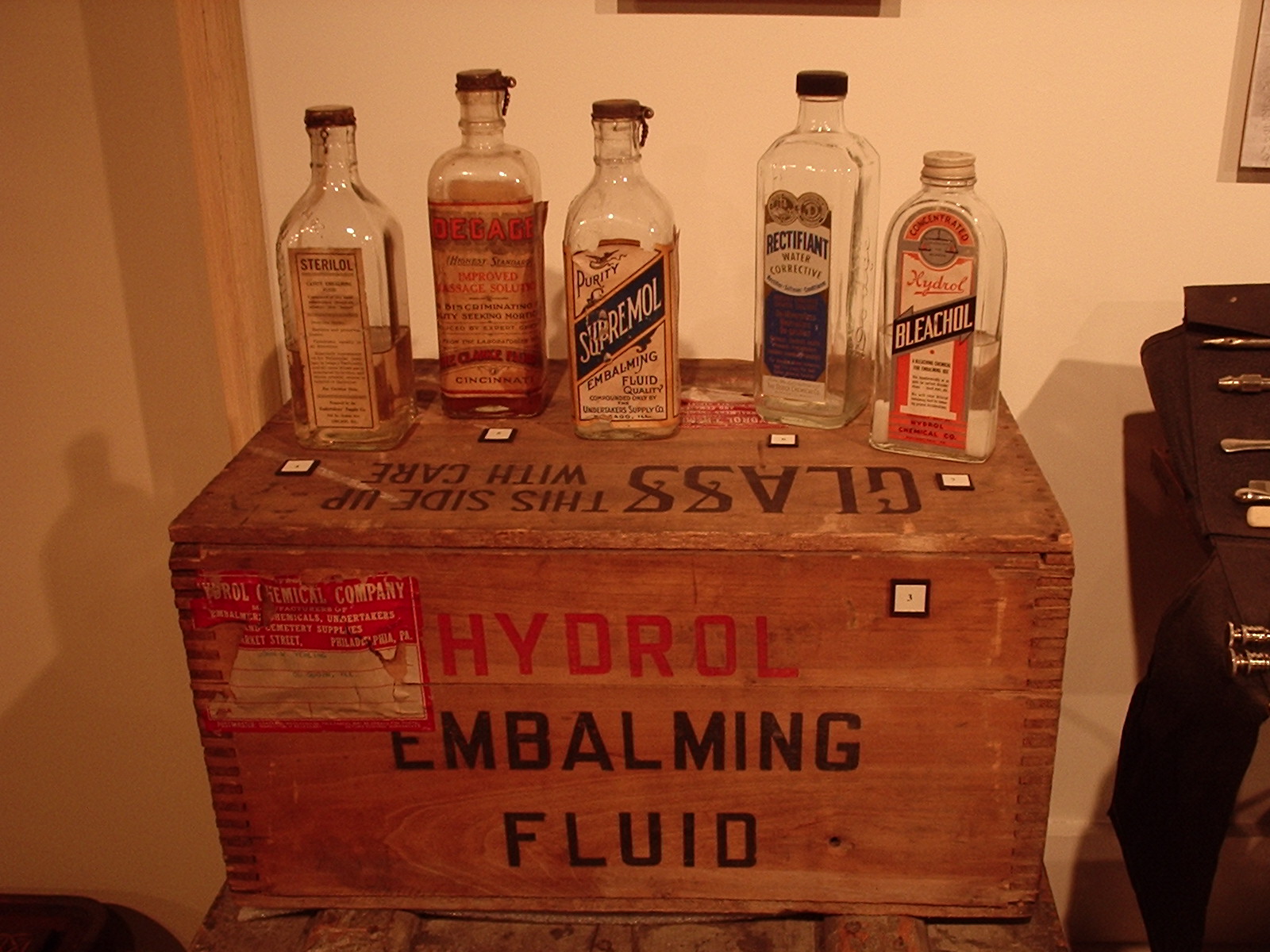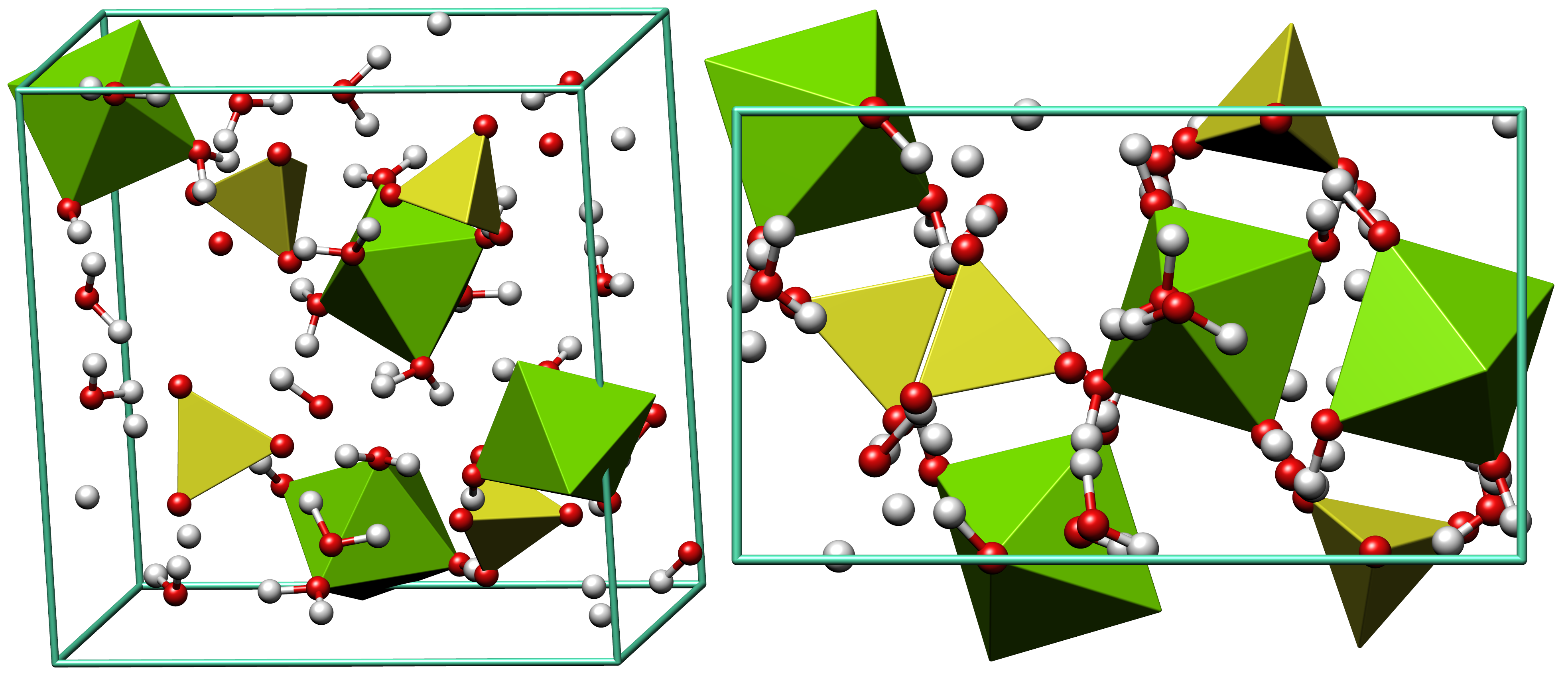|
Embalming Fluid
Embalming chemicals are a variety of preservatives, sanitising and disinfectant agents, and additives used in modern embalming to temporarily prevent decomposition and restore a natural appearance for viewing a body after death in funeral homes. A mixture of these chemicals is known as embalming fluid and is used to preserve bodies of deceased persons for both funeral purposes and in medical research in anatomical laboratories. The period for which a body is embalmed is dependent on time, expertise of the embalmer and factors regarding duration of stay and purpose. Typically, embalming fluid contains a mixture of formaldehyde, glutaraldehyde, methanol, and other solvents. The formaldehyde content generally ranges from 5–37% and the methanol content may range from 9–56%. In the United States alone, about 20 million liters (roughly 5.3 million gallons) of embalming fluid are used every year.Sehee, Joe (2007)Green Burial: It's Only Natural PERC Reports, Winter 2007. Re ... [...More Info...] [...Related Items...] OR: [Wikipedia] [Google] [Baidu] |
Cremation
Cremation is a method of Disposal of human corpses, final disposition of a corpse through Combustion, burning. Cremation may serve as a funeral or post-funeral rite and as an alternative to burial. In some countries, including India, Nepal, and Syria, cremation on an Pyre, open-air pyre is an ancient tradition. Starting in the 19th century, cremation was introduced or reintroduced into other parts of the world. In modern times, cremation is commonly carried out with a Crematorium, closed furnace (cremator), at a crematorium. Cremation leaves behind an average of of remains known as ''ashes'' or ''cremains''. This is not all ash but includes unburnt fragments of bone mineral, which are commonly ground into powder. They are inorganic and inert, and thus do not constitute a health risk and may be buried, interred in a memorial site, retained by relatives or scattered in various ways. History Ancient Cremation dates from at least 17,000 years ago in the archaeological record, w ... [...More Info...] [...Related Items...] OR: [Wikipedia] [Google] [Baidu] |
Epsom Salts
Epsomite, Epsom salt, or magnesium sulfate heptahydrate, is a hydrous magnesium sulfate mineral with formula . Physical properties Epsomite crystallizes in the orthorhombic system. The normal form is as massive encrustations, while acicular or fibrous crystals are rarely found. It is colorless to white with tints of yellow, green and pink. It is a soft mineral with variable Mohs hardness around 2.0~2.5, and it has a low specific gravity It is readily soluble in water, and absorbs water from the air. It converts to hexahydrate with the loss of one water molecule and a switch to monoclinic structure. The epsomite group includes solid solution series with morenosite (·) and goslarite (·). Etymology It was first systematically described in 1806 for an occurrence near Epsom, Surrey, England, after which it was named. It has been also referred to as "cave cotton" when in its fibrous form. Occurrence Epsomite forms as encrustations or efflorescences on limestone cave ... [...More Info...] [...Related Items...] OR: [Wikipedia] [Google] [Baidu] |
Speciality Chemicals
Specialty chemicals (also called specialties or effect chemicals) are particular chemical products that provide a wide variety of effects on which many other industry sectors rely. Some of the categories of speciality chemicals are adhesives, agrichemicals, Cleaning agent, cleaning materials, colors, Cosmetics ingredients, cosmetic additives, construction chemicals, elastomers, Flavoring, flavors, food additives, fragrances, industrial gases, lubricants, paints, polymers, surfactants, and textile auxiliaries. Other industrial sectors such as Automobile industry, automotive, Aerospace manufacturer, aerospace, Food manufacturing, food, cosmetics, agriculture, Manufacturing industry, manufacturing, and textiles are highly dependent on such products. Speciality chemicals are materials used on the basis of their performance or function. Consequently, in addition to "effect" chemicals they are sometimes referred to as "performance" chemicals or "formulation" chemicals. They can be unique ... [...More Info...] [...Related Items...] OR: [Wikipedia] [Google] [Baidu] |
Tissue Gas
Tissue may refer to: Biology * Tissue (biology), an ensemble of similar (or dissimilar in structure but same in origin) cells that together carry out a specific function * ''Triphosa haesitata'', a species of geometer moth ("tissue moth") found in North America * ''Triphosa dubitata'', a species of geometer moth ("tissue") found in Afro-Eurasia Paper products * Tissue paper, a type of thin, gauzy translucent paper used for wrapping and cushioning items * Tissue (cloth), a thin, transparent, and lightweight fabric * Facial tissue, tissue paper used for cleaning the face * Japanese tissue, tissue paper from Japan made of vegetable fibers * Toilet paper, tissue paper used for cleaning the anus * Wrapping tissue, tissue paper used for wrapping and cushioning items Other * Aerial tissue, an acrobatic art form and one of the circus arts * "The Tissue (Tomaranai Seishun) is the third single by the Japanese girl idol group Shiritsu Ebisu Chugaku (or fourth counting one cover single), ... [...More Info...] [...Related Items...] OR: [Wikipedia] [Google] [Baidu] |
Disinfectant
A disinfectant is a chemical substance or compound used to inactivate or destroy microorganisms on inert surfaces. Disinfection does not necessarily kill all microorganisms, especially resistant bacterial spores; it is less effective than sterilization, which is an extreme physical or chemical process that kills all types of life. Disinfectants are generally distinguished from other antimicrobial agents such as antibiotics, which destroy microorganisms within the body, and antiseptics, which destroy microorganisms on living tissue. Disinfectants are also different from biocides—the latter are intended to destroy all forms of life, not just microorganisms. Disinfectants work by destroying the cell wall of microbes or interfering with their metabolism. It is also a form of decontamination, and can be defined as the process whereby physical or chemical methods are used to reduce the amount of pathogenic microorganisms on a surface. Disinfectants can also be used to dest ... [...More Info...] [...Related Items...] OR: [Wikipedia] [Google] [Baidu] |
Edema
Edema (American English), also spelled oedema (British English), and also known as fluid retention, swelling, dropsy and hydropsy, is the build-up of fluid in the body's tissue (biology), tissue. Most commonly, the legs or arms are affected. Symptoms may include skin that feels tight, the area feeling heavy, and joint stiffness. Other symptoms depend on the underlying cause. Causes may include Chronic venous insufficiency, venous insufficiency, heart failure, kidney problems, hypoalbuminemia, low protein levels, liver problems, deep vein thrombosis, infections, kwashiorkor, angioedema, certain medications, and lymphedema. It may also occur in immobile patients (stroke, spinal cord injury, aging), or with temporary immobility such as prolonged sitting or standing, and during menstruation or pregnancy. The condition is more concerning if it starts suddenly, or pain or shortness of breath is present. Treatment depends on the underlying cause. If the underlying mechanism involve ... [...More Info...] [...Related Items...] OR: [Wikipedia] [Google] [Baidu] |
Humectant
A humectant is a hygroscopic (water-absorbing) substance used to keep things moist. They are used in many products, including food, cosmetics, medicines and pesticides. When used as a food additive, a humectant has the effect of keeping moisture in the food. Humectants are sometimes used as a component of antistatic coatings for plastics. A humectant attracts and retains the moisture in the air nearby via absorption, drawing the water vapor into or beneath the organism's or object's surface. This is the opposite use of a hygroscopic material where it is used as a desiccant used to draw moisture away. In pharmaceuticals and cosmetics, humectants can be used in topical dosage forms to increase the solubility of a chemical compound's active ingredients, increasing the active ingredients' ability to penetrate skin, or its activity time. This hydrating property can also be needed to counteract a dehydrating active ingredient (e.g., soaps, corticoids, and some alcohols), which ... [...More Info...] [...Related Items...] OR: [Wikipedia] [Google] [Baidu] |
Jaundice
Jaundice, also known as icterus, is a yellowish or, less frequently, greenish pigmentation of the skin and sclera due to high bilirubin levels. Jaundice in adults is typically a sign indicating the presence of underlying diseases involving abnormal heme metabolism, liver dysfunction, or biliary-tract obstruction. The prevalence of jaundice in adults is rare, while jaundice in babies is common, with an estimated 80% affected during their first week of life. The most commonly associated symptoms of jaundice are itchiness, pale feces, and dark urine. Normal levels of bilirubin in blood are below 1.0 mg/ dl (17 μmol/ L), while levels over 2–3 mg/dl (34–51 μmol/L) typically result in jaundice. High blood bilirubin is divided into two types: unconjugated and conjugated bilirubin. Causes of jaundice vary from relatively benign to potentially fatal. High unconjugated bilirubin may be due to excess red blood cell breakdown, large bruises, gen ... [...More Info...] [...Related Items...] OR: [Wikipedia] [Google] [Baidu] |
Alkaline
In chemistry, an alkali (; from the Arabic word , ) is a basic salt of an alkali metal or an alkaline earth metal. An alkali can also be defined as a base that dissolves in water. A solution of a soluble base has a pH greater than 7.0. The adjective alkaline, and less often, alkalescent, is commonly used in English as a synonym for basic, especially for bases soluble in water. This broad use of the term is likely to have come about because alkalis were the first bases known to obey the Arrhenius definition of a base, and they are still among the most common bases. Etymology The word ''alkali'' is derived from Arabic ''al qalīy'' (or ''alkali''), meaning (see calcination), referring to the original source of alkaline substances. A water-extract of burned plant ashes, called potash and composed mostly of potassium carbonate, was mildly basic. After heating this substance with calcium hydroxide (''slaked lime''), a far more strongly basic substance known as ''caustic ... [...More Info...] [...Related Items...] OR: [Wikipedia] [Google] [Baidu] |
Formalin
Formaldehyde ( , ) (systematic name methanal) is an organic compound with the chemical formula and structure , more precisely . The compound is a pungent, colourless gas that polymerises spontaneously into paraformaldehyde. It is stored as aqueous solutions (formalin), which consists mainly of the hydrate CH2(OH)2. It is the simplest of the aldehydes (). As a precursor to many other materials and chemical compounds, in 2006 the global production of formaldehyde was estimated at 12 million tons per year. It is mainly used in the production of industrial resins, e.g., for particle board and coatings. Formaldehyde also occurs naturally. It is derived from the degradation of serine, dimethylglycine, and lipids. Demethylases act by converting N-methyl groups to formaldehyde. Formaldehyde is classified as a group 1 carcinogen and can cause respiratory and skin irritation upon exposure. Forms Formaldehyde is more complicated than many simple carbon compounds in that it ... [...More Info...] [...Related Items...] OR: [Wikipedia] [Google] [Baidu] |
Phenol
Phenol (also known as carbolic acid, phenolic acid, or benzenol) is an aromatic organic compound with the molecular formula . It is a white crystalline solid that is volatile and can catch fire. The molecule consists of a phenyl group () bonded to a hydroxy group (). Mildly acidic, it requires careful handling because it can cause chemical burns. It is acutely toxic and is considered a health hazard. Phenol was first extracted from coal tar, but today is produced on a large scale (about 7 million tonnes a year) from petroleum-derived feedstocks. It is an important industrial commodity as a precursor to many materials and useful compounds, and is a liquid when manufactured. It is primarily used to synthesize plastics and related materials. Phenol and its chemical derivatives are essential for production of polycarbonates, epoxies, explosives such as picric acid, Bakelite, nylon, detergents, herbicides such as phenoxy herbicides, and numerous pharmaceuti ... [...More Info...] [...Related Items...] OR: [Wikipedia] [Google] [Baidu] |




